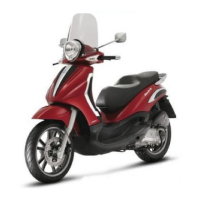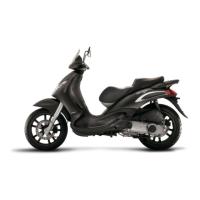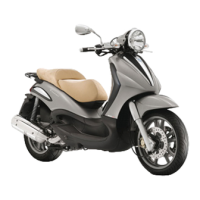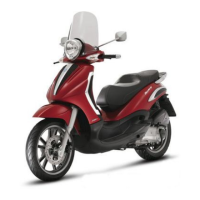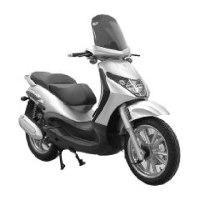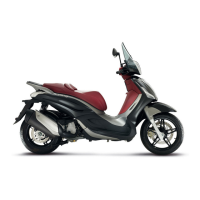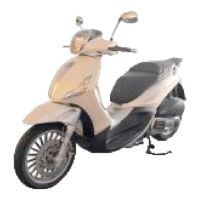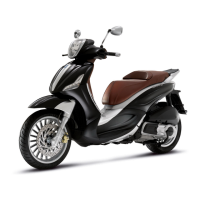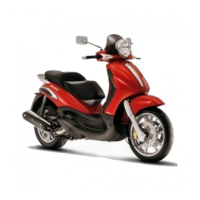Do you have a question about the PIAGGIO Beverly Tourer 250 i.e. and is the answer not in the manual?
General safety guidelines for vehicle maintenance operations, covering ventilation, battery handling, and fuel safety.
Guidelines for using genuine parts, appropriate tools, and proper procedures for maintenance and repair.
Details on how to identify the vehicle's chassis and engine prefixes using specific markings.
Specifications for the vehicle's overall dimensions, kerb weight, and maximum allowed weight.
Technical specifications for the engine, including type, capacity, bore, stroke, and power output.
Details on the transmission system, including variator type, clutch, and final reduction unit.
Fluid capacities for engine oil, transmission oil, cooling system, fuel tank, and fork oil.
Specifications for the vehicle's electrical components and systems, including ignition and battery.
Information on the chassis type, front and rear suspension systems, and their specifications.
Details on the braking system, including front and rear disc specifications and hydraulic controls.
Specifications for wheels, tyres, and recommended tyre pressures for the vehicle.
Specific torque values for various fasteners in steering, chassis, and suspension systems.
Torque specifications for steering components like ring nuts and handlebar screws.
Torque specifications for chassis components such as center stand and side stand bolts.
Torque specifications for front suspension elements including fork plates and wheel axles.
Torque specifications for rear suspension components like shock absorber clamps and wheel axles.
Torque specifications for flywheel-related components like cover screws and nut.
Torque specifications for crankcase and crankshaft assembly components.
Torque specifications for cooling system components like water pump and thermostat covers.
Technical data and specifications for engine overhaul procedures and component clearances.
Specifications for assembly clearances of engine components like the cylinder-piston assembly.
Details on the cylinder and piston assembly, including dimensions and clearances.
Categorization of engine coupling based on cylinder and piston specifications.
Procedures for measuring and checking clearances in the crankcase, crankshaft, and connecting rod assembly.
Specifications for crankshaft categories and their corresponding quantities.
Specifications for crankcase categories and their corresponding quantities.
Details on coupling categories between crankshaft and crankcase halves using specific bearings.
Specifications and measurement procedures for axial clearance in the crankshaft/crankcase assembly.
Explanation of the shimming system used to adjust compression ratio correctly.
Table detailing shimming measurements and corresponding thicknesses for engine adjustments.
Table of recommended products for vehicle maintenance and their specifications.
Conversions between English and International System units for various measurements.
List of specialized tools required for vehicle maintenance and repair, with codes and descriptions.
Scheduled maintenance table outlining checks and replacements at specified mileage intervals.
Procedure for checking ignition timing using a diagnostic tester and stroboscopic light.
Instructions for servicing the spark plug, including removal, inspection, and torque specifications.
Procedures for checking and replacing hub oil, including capacity and torque specifications.
Recommended oil products for rear hub lubrication and their specifications.
Characteristic specifications for rear hub oil, including capacity.
Procedure for accessing, cleaning, and replacing the air filter element.
Instructions for checking and topping up engine oil, including capacity and filter replacement.
Recommended engine oil products and their specifications for the vehicle.
Characteristic specifications for engine oil, detailing capacity and filter replacement frequency.
Explanation of the oil pressure warning light function and when to check the lubrication system.
Procedure for checking and verifying the ignition timing using diagnostic tools.
Procedures for checking and maintaining the vehicle's cooling system.
Procedure for checking the coolant level in the expansion tank and safety warnings.
Recommended coolant product and its specifications for the vehicle.
Information and procedures related to the vehicle's braking system components.
Procedure for checking the brake fluid level in the reservoirs through the sight glass.
Recommended brake fluid products and their specifications for topping up and system changes.
Procedure for adjusting the vehicle's headlights to comply with road regulations.
Troubleshooting guide for engine performance issues, including starting difficulties and poor operation.
Identifies possible causes for poor engine performance and outlines corrective operations.
Lists common causes for difficult engine starting and the corresponding troubleshooting steps.
Troubleshooting guide for excessive oil consumption or exhaust smoke issues.
Diagnoses and resolves issues related to insufficient oil pressure in the engine lubrication system.
Troubleshooting for issues related to the transmission and braking systems.
Addresses problems with clutch engagement or slippage, and their potential causes.
Troubleshooting steps for inefficient braking system performance, including pad and disc checks.
Diagnoses and resolves causes of brake overheating, such as caliper issues or disc distortion.
Troubleshooting guide for steering and suspension system problems.
Diagnoses and resolves issues causing heavy or stiff steering.
Troubleshooting for excessive play or looseness in the steering system.
Identifies potential causes for noise originating from the suspension system.
Troubleshooting steps for oil leaks from suspension components, focusing on seal faults.
Diagrams and descriptions of the location of key electrical components on the vehicle.
Layout and identification of electrical components located on the front side of the vehicle.
Layout and identification of electrical components located on the back side of the vehicle.
Procedures for checking and inspecting various electrical system components.
Description of the immobilizer system, its components, and function.
List of specific tools required for immobilizer system diagnostics and programming.
Procedure for programming keys and establishing the immobilizer system in a virgin state.
Explanation of diagnostic codes displayed by the immobilizer system via an LED indicator.
Details on the ignition system, including HV coil resistance and battery recharge circuit.
Troubleshooting steps for ignition system issues when there is no spark at the spark plug.
Information on the battery recharge system, including alternator and voltage regulator.
Procedure for checking the stator winding resistance and continuity.
Procedure for checking the voltage regulator output and control voltage.
Steps for checking the overall recharge system voltage and battery condition.
Procedure for checking the charging current output of the electrical system.
Details and checks related to the starter motor and its electrical connections.
Wiring diagram and checks for the horn control system.
Procedure for checking the operation and continuity of the turn signal system.
Checks and troubleshooting for various level indicators on the vehicle's electrical system.
List of all bulbs used in the vehicle's lighting system with their specifications.
Information on the location and specifications of all fuses in the electrical system.
Identification and function of indicators and controls on the vehicle's instrument panel.
Maintenance and recharging instructions for sealed batteries after open-circuit storage.
Detailed steps for recharging batteries that have been stored for an extended period.
Instructions for commissioning and charging a new dry-charged battery.
Step-by-step guide for preparing and charging a new dry-charged battery.
Procedure for checking the operation and continuity of remote control components.
Procedure for checking the continuity of various switches based on their position.
Identification and diagrams of various electrical connectors used in the system.
Details of the instrument cluster connector 'A' and its terminal assignments.
Details of the immobilizer aerial connector and its wiring.
Details of the fuel pump connector and its terminal assignments.
Details of the electric fan connector and its wiring.
Details of the electronic control unit connector for injection system.
Details of the injector connector and its terminal assignments.
Procedures and considerations for the installation of the vehicle's electrical system.
Step-by-step instructions for removing the exhaust assembly, including the lambda probe.
Detailed procedure for safely removing the engine from the vehicle.
Information on the automatic transmission system, including its components and operation.
Procedure for removing and refitting the transmission cover, including specific tooling.
Instructions for removing and refitting the air intake cover for the transmission compartment.
Procedure for removing the bearing from the driven pulley shaft.
Instructions for refitting the driven pulley shaft bearing, with cautions for paint protection.
Inspection and service for the baffle roller component.
Inspection and service for the plastic roller, including diameter checks and torque settings.
Procedure for removing the driven pulley assembly from the engine.
Procedure for inspecting the clutch drum, including diameter and eccentricity checks.
Method for checking the working surface eccentricity of the clutch bell using specialized tools.
Procedure for removing the clutch assembly using specific tools and precautions.
Procedure for inspecting the clutch, including friction material thickness and mass condition.
Procedure for removing the pin retaining collar from the pulley assembly.
Procedure for removing the bearing from the driven half-pulley.
Inspection of the driven fixed half-pulley, checking diameter, contact surface, and joints.
Inspection of the driven sliding half-pulley, checking diameter, contact surface, and joints.
Procedure for refitting the bearing into the driven half-pulley.
Procedure for refitting the driven pulley assembly, including oil guards and O-rings.
Procedure for inspecting the clutch spring, checking its standard and minimum length.
Procedure for refitting the clutch assembly using specific tools and precautions.
Inspection of the drive belt for damage and width, and checking for wear signs.
Procedure for removing the driving pulley from the crankshaft.
Inspection of the rollers case, checking bushings, rollers, and housings for wear.
Procedure for refitting the driving pulley assembly, including pre-assembly and shaft fitting.
Procedure for refitting the transmission cover, ensuring gasket and dowel alignment.
Procedures for removing and servicing the end gear assembly.
Procedure for removing the hub cover and its gasket.
Procedure for removing the wheel axle and its associated gears.
Procedure for removing hub bearings, checking their condition, and using specific tools.
Procedure for removing wheel axle bearings using appropriate tools.
Procedure for removing the driven pulley shaft bearing and associated oil guard.
Inspection of the hub shaft for wear or distortion of surfaces and housings.
Inspection of the hub cover for surface integrity and bearing condition.
Procedure for refitting the wheel axle bearing using specific tools and heat.
Procedure for refitting hub cover bearings, requiring heating and specific tools.
Procedure for refitting the hub cover, including gasket and breather pipe alignment.
Procedures for removing and refitting the flywheel cover and associated components.
Procedure for removing the hub cover, including hose clips and fixings.
Procedure for removing the stator and its associated wiring.
Procedure for refitting the stator and flywheel, ensuring correct torque and alignment.
Procedure for refitting the flywheel cover, ensuring correct spline and shaft alignment.
Procedures related to the flywheel assembly and engine starting.
Procedure for removing the starter motor from its seat.
Procedure for removing the flywheel magneto, including shaft clip and alignment.
Inspection of internal flywheel components and the Pick-Up control plate.
Procedure for refitting the free wheel, ensuring clean surfaces and correct screw application.
Procedure for refitting the flywheel magneto, including free wheel and transmission gear.
Procedure for refitting the starter motor, including O-ring lubrication and screw torque.
Procedures related to the cylinder assembly and the engine timing system.
Procedure for removing the intake manifold and securing it properly upon refitting.
Procedure for removing the rocker-arms cover.
Procedure for removing timing system components like the chain, sprockets, and tensioner.
Procedure for removing the cam shaft and its associated components.
Procedure for removing the cylinder head, including spark plug and fastening nuts.
Procedure for removing valves, cotters, springs, and oil guards using specialized tools.
Procedure for removing the cylinder and piston assembly, with cautions for piston support.
Inspection of the small end of the connecting rod, checking diameter and wear.
Inspection of the wrist pin, measuring its diameter and calculating coupling clearance.
Inspection of the piston, checking wrist pin seat, diameter, and ring groove clearances.
Specifications for fitting clearances of piston rings and checking cylinder head surface.
Procedure for inspecting the cylinder, measuring inner diameter and checking head coupling surface.
Procedure for inspecting piston rings, measuring opening and checking clearances.
Procedure for removing the piston, aligning it with the connecting rod and installing stop rings.
Information on the shimming system for adjusting compression ratio and selecting the correct gasket.
Procedure for refitting piston rings, ensuring correct orientation and gap offset.
Procedure for refitting the cylinder, including base gasket and lubrication.
Inspection of the cylinder head surface, camshaft, and rocker components for wear.
Inspection of timing system components like guide shoes, chain, and tensioner.
Procedure for inspecting valve sealings by filling the manifold with petrol.
Inspection of valve housings, measuring seat width and valve guide diameter.
Inspection of valves, measuring sealing surface width and valve stem diameter.
Inspection of valve springs and half-cones for signs of wear or yielding.
Procedure for refitting valves, springs, and caps, including lubrication and sealing.
Inspection of the cam shaft for wear on cams, height, and retaining plate.
Procedure for refitting the cylinder head and timing system components, including torque sequences.
Procedure for refitting the rocker-arms cover, ensuring proper gasket seating and torque.
Procedure for refitting the intake manifold, ensuring correct torque and alignment.
Procedures for splitting and inspecting the crankcase and crankshaft assembly.
Procedure for splitting the crankcase halves, including crankshaft axial clearance check.
Procedure for inspecting the crankshaft alignment on its support.
Inspection of crankcase halves for cleanliness, surface integrity, and alignment.
Inspection of crankshaft plain bearings for lubrication and positioning.
Procedure for refitting the crankcase halves, including gasket, bushings, and screws.
Checks and replacement procedures for stud bolts in the crankcase.
Information and diagrams related to the engine lubrication system.
Conceptual diagrams illustrating the engine's lubrication circuit.
Diagram of the engine's lubrication circuit, showing key components and flow.
Procedure for checking engine oil pressure at different RPMs and identifying potential issues.
Procedures for removing and refitting crankshaft oil seals.
Steps for removing the oil seal from the crankshaft.
Procedure for refitting the oil seal using appropriate tools and lubrication.
Procedures for removing, inspecting, and refitting the engine oil pump.
Steps for removing the oil pump cover, chain, and pump body.
Procedure for inspecting the oil pump rotors and reassembling the unit.
Procedure for refitting the oil pump cover, ensuring proper gasket alignment and screw torque.
Procedure for removing the oil sump, including draining oil and removing associated parts.
Inspection of the by-pass valve, checking spring length, piston condition, and seal.
Procedure for refitting the oil sump, including by-pass valve, spring, and gasket.
Layout and identification of injection system components on the vehicle.
Overview of the integrated injection and ignition system and its management parameters.
Important precautions and troubleshooting hints related to the MIU injection system.
Guidance on troubleshooting common MIU system faults, focusing on connections and power supply.
Diagrams illustrating the terminal setup for the MIU control unit connectors.
Table detailing terminal assignments for various connectors in the injection system.
Electrical schematic diagram for the Engine Management System (EMS).
Wiring diagram for the injection system, showing component connections.
General troubleshooting steps for engine starting and running issues.
Troubleshooting for engine starting failures, covering immobilizer, fuel supply, and ignition.
Troubleshooting for engine stalling or unstable idling, related to faults and parameter correctness.
Troubleshooting for engine not returning to idle speed or having excessively high idle speed.
Troubleshooting for exhaust backfires occurring during deceleration.
Troubleshooting for irregular engine performance, especially at slight throttle openings.
Troubleshooting for poor engine performance at full throttle or irregular pickup.
Troubleshooting guide for engine knocking or combustion shock issues.
Description of the fuel supply circuit, including pump, filter, regulator, and injector.
Procedure for removing the butterfly valve assembly.
Procedure for refitting the butterfly valve, ensuring correct clip and angle alignment.
Diagram of the pump supply circuit, showing connections and injection loads.
List of electrical loads within the injection system and their specifications.
Procedure for performing a circuit leak test on the fuel system using specialized tools.
Procedure for checking and replacing the fuel filter.
Checks and procedures for inspecting the injector circuit and its components.
List of electrical loads within the injection system and their specifications.
Procedure for inspecting the injector hydraulics, including manifold removal and seal tests.
Diagrams showing the physical location of injection system components on the vehicle.
Table identifying and locating injection system components.
Checks and procedures for the tachometer sensor and its connection to the control unit.
Information on the High Voltage (HT) coil and its role in the ignition system.
List of electrical loads within the injection system and their specifications.
Checks and resistance values for the coolant temperature sensor.
Details on the temperature sensor, its connections, and resistance values.
Procedure for resetting the throttle valve position sensor (TPS reset).
Step-by-step guide for performing the TPS reset procedure using a diagnostic tester.
Description and checks for the Lambda sensor, including its function and electrical data.
List of electrical loads within the injection system and their specifications.
Procedures related to the front suspension system, including wheel and hub overhaul.
Step-by-step instructions for removing the front wheel.
Procedure for overhauling the front wheel hub, including bearing replacement.
Procedure for refitting the front wheel, including greasing and torque specifications.
Procedures for removing and refitting the handlebar assembly.
Steps for removing the handlebar, including covers, mirrors, and steering tube connection.
Procedure for refitting the handlebar, ensuring alignment and proper torque.
Procedures for removing, overhauling, and refitting the front fork.
Steps for removing the front fork components, including stem and springs.
Procedure for overhauling the front fork, including disassembly and component checks.
Instructions for cleaning and checking all components of the front fork assembly.
Procedure for refitting the front fork components, including oil seals and hydraulic rod.
Recommended oil and grease products for front fork lubrication and assembly.
Specifications for oil quantity per fork stem.
Procedures for bleeding the hydraulic rod and refitting the steering column components.
Steps for removing the handlebar components, including covers, cables, and steering tube nuts.
Procedure for refitting the steering column, including fifth wheel tracks and lubrication.
Recommended grease products for steering bearings and related components.
Procedure for removing steering bearing components, including cleaning and inspection.
Procedure for removing steering fifth wheel tracks from the chassis and headstock.
List of specific tools required for removing steering fifth wheel tracks.
Procedure for refitting steering fifth wheel tracks and seats, including lubrication.
Procedure for fitting new steering fifth wheel tracks onto the headstock and steering tube.
Recommended grease products for steering fifth wheel tracks and bearings.
Procedures related to the rear suspension system, including wheel and swing-arm.
Step-by-step instructions for removing the rear wheel.
Procedure for refitting the rear wheel, observing tightening torques.
Procedures for removing, overhauling, and refitting the swing-arm assembly.
Steps for removing the swing-arm, including loosening nuts and spindles.
Procedure for overhauling the swing-arm, including silent bloc inspection and removal.
Specific tool required for silent bloc removal and fitting.
Specifications for swing-arm axial clearance and allowable limits.
Procedure for refitting the swinging arm assembly, including clamp positioning and bolt tightening.
Procedures for removing and refitting the shock absorbers.
Steps for removing the shock absorbers, including engine lifting and muffler removal.
Procedure for refitting the shock absorbers, in reverse order of removal.
Procedures for removing and overhauling the exhaust bracket.
Steps for removing the exhaust bracket components, including bearings.
Procedure for overhauling the exhaust bracket, including bearing removal.
Specific tools required for exhaust bracket overhaul.
Procedure for refitting the exhaust bracket components, including bearing installation.
Procedures for removing and refitting the centre stand.
Procedures for removing and refitting the side stand.
Steps for removing the side stand, including springs and nuts.
Procedure for fitting the side stand, in reverse order of removal.
Rules and warnings for working on the braking system, emphasizing fluid safety and handling.
Procedures for removing and refitting the rear brake caliper.
Steps for removing the rear brake caliper, including fluid hose fittings.
Procedure for refitting the rear brake caliper, including system bleeding and copper washers.
Procedures for removing and refitting the front brake caliper.
Steps for removing the front brake caliper, including retainer and pipe fittings.
Procedure for refitting the front brake caliper, including system bleeding.
Procedures for removing and refitting the rear brake disc.
Steps for removing the rear brake disc, involving wheel removal and screw loosening.
Procedure for refitting the rear brake disc, ensuring correct orientation and torque.
Procedure for inspecting the brake disc, checking for cleanliness, scoring, and axial run-out.
Procedures for removing, refitting, and inspecting the front brake disc.
Procedure for inspecting the front brake disc, checking thickness, scoring, and axial run-out.
Procedures for removing, checking, and replacing the front brake pads.
Steps for removing the front brake pads, including caliper and pin loosening.
Minimum thickness specification for front brake pads.
Procedure for refitting the front brake pads, ensuring correct caliper positioning and torque.
Procedures for removing, checking, and replacing the rear brake pads.
Steps for removing the rear brake pads, including caliper and pin loosening.
Procedure for refitting the rear brake pads, ensuring correct caliper positioning and torque.
Instructions for filling the braking system after pad replacement.
Procedure for bleeding the combined rear braking system.
Procedure for bleeding the front braking system.
Procedure for checking the brake fluid level in the reservoirs.
Procedures for removing and refitting the front brake pump.
Steps for removing the front brake pump, including handlebar cover and brake line disconnection.
Procedure for refitting the front brake pump, including hydraulic line tightening and system purging.
Procedures for removing and refitting the combined rear brake pump.
Steps for removing the rear brake pump, including handlebar cover and brake line disconnection.
Procedure for refitting the rear brake pump, including hydraulic line tightening and system purging.
Diagram illustrating the coolant flow circuit, identifying key components.
Procedure for checking the electric fan operation and battery voltage.
Procedure for bleeding the cooling system to remove air bubbles.
Steps for removing the thermostat cover and thermostat.
Procedure for checking the thermostat's operation by testing its opening temperature.
Procedure for refitting the thermostat and cover, ensuring correct alignment and torque.
Procedures for replacement of radiator components like expansion tank and fan.
Procedure for removing the vehicle's saddle.
Procedure for removing the side fairings and bumper components.
Procedure for removing the rear luggage rack.
Procedure for removing the rear handlebar cover, including windshield and mirrors.
Procedure for removing the instrument panel from the handlebar cover.
Procedure for removing the front handlebar cover and headlight assembly.
Procedure for removing the headlight assembly.
Procedure for removing the central frame cover, including fuel tank access.
Procedure for removing the legshield components.
Procedure for removing the knee-guard components.
Procedure for removing the ignition key-switch when in the 'off' position.
Procedure for removing the ignition key-switch when in the 'lock' position.
Procedures for removing the front wheel housing components.
Procedure for removing the taillight assembly.
Procedure for removing the vehicle's footrests.
Procedure for removing the central frame cover components.
Procedure for removing the side fairings, including saddle and luggage rack.
Procedure for removing and accessing the air filter.
Procedure for removing the rear mudguard.
Procedure for removing the helmet bay components, including fairings and battery.
Procedures for removing the fuel tank, including electrical connections and fuel lines.
Procedure for removing the front mudguard.
Procedure for removing the radiator fan assembly.
Procedure for removing the flyscreen and windshield.
Check of the vehicle's appearance, including paintwork, plastics, and cleanliness.
Inspection of critical tightening torques on suspension, brake, and electrical components.
Pre-delivery check of the main electrical system functions, including lights and switches.
Check of essential fluid levels: brake, hub oil, coolant, and engine oil.
Procedure for conducting a road test to evaluate vehicle performance and handling.
Specific checks to perform during the road test, including cold start and throttle response.
Static checks performed after the road test, including engine restart and tyre pressure.
Final functional checks of braking, clutch, engine, and other vehicle systems.
Repair time estimates for engine-related operations like removal, oil change, and complete service.
Repair time estimates for crankcase operations, including gasket and crankcase replacement.
Repair time estimates for crankshaft replacement.
Repair time estimates for cylinder-piston assembly, pin, rings, and service.
Repair time estimates for cylinder head, valves, gasket, and sensor replacement.
Repair time estimates for rocker arm valve, camshaft, and decompressor replacement.
Repair time estimates for spark plug, head cover, gasket, and vapour recovery pipe replacement.
Repair time estimates for oil filter, oil pressure sensor, and net oil filter replacement.
Repair time estimates for flywheel cover, gasket, water pump, and oil seal replacement.
Repair time estimates for clutch, driven pulley, and clutch bell replacement.
Repair time estimates for oil pump components like chain guides, chain, and cover flap.
Repair time estimates for final reduction gear, wheel axle, and breather pipe replacement.
Repair time estimates for driving pulley components, belt, and variator rollers.
Repair time estimates for transmission cover, crankcase cover, and bearing replacement.
Repair time estimates for water pump cover and head-pump coupling replacement.
Repair time estimates for starter motor, driven gearing, and pinion replacement.
Repair time estimates for stator, rotor, flywheel, and freewheel replacement.
Repair time estimates for throttle body, injector, and intake manifold replacement.
Repair time estimates for muffler, lambda probe, and exhaust manifold replacement.
Repair time estimates for air filter box, filter element, and cleaner/carburettor union replacement.
Repair time estimates for chassis replacement and footrest bracket replacement.
Repair time estimates for centre stand bolt and stand replacement.
Repair time estimates for legshield, shield rim, and central cover replacement.
Repair time estimates for rear side panels and rear fairing replacement.
Repair time estimates for shield back plate and glove box door replacement.
Repair time estimates for fuel tank lid, central chassis cover, and spark plug flap replacement.
Repair time estimates for underseat band, glove-box switch, and helmet compartment components.
Repair time estimates for license plate holder support and holder replacement.
Repair time estimates for front mudguard, spoiler, and rear mudguard replacement.
Repair time estimates for fuel tank breather, fuel tank, and tank float replacement.
Repair time estimates for muffler support arm and rear shock absorber replacement.
Repair time estimates for front and rear handlebar cover replacement.
Repair time estimates for throttle control, knobs, and mirrors replacement.
Repair time estimates for swing-arm, engine attachment, silent-block, and flange replacement.
Repair time estimates for brake piping, pads, caliper, and fluid system replacement.
Repair time estimates for saddle and saddle cover replacement.
Repair time estimates for odometer, glass, warning lights, and clock replacement.
Repair time estimates for luggage rack and luggage rack cover replacement.
Repair time estimates for anti-theft lock, saddle lock, and immobilizer aerial replacement.
Repair time estimates for front and rear lights, bulbs, and indicators replacement.
Repair time estimates for front wheel axle, bearings, tyre, rim, and brake disc replacement.
Repair time estimates for rear wheel, tyre, rim, and brake disc replacement.
Repair time estimates for fuel pump and injector pump pipe replacement.
Repair time estimates for voltage regulator, HV coil, and spark plug cap replacement.
Repair time estimates for voltage regulator replacement.
Repair time estimates for remote controls, battery, and switches replacement.
Repair time estimates for fuse holder and electrical system replacement.
Repair time estimates for headlight switch, horn button, and starter button replacement.
Repair time estimates for transmission assembly, cable, and fuel tank cap drive replacement.
Repair time estimates for fork, sheath, stem, and oil seal replacement.
Repair time estimates for radiator components like expansion tank and fan replacement.
Repair time estimates for radiator, fan, and coolant pipe replacement.
Repair time estimates for windscreen glass replacement.
Repair time estimates for plates and stickers replacement.
General safety guidelines for vehicle maintenance operations, covering ventilation, battery handling, and fuel safety.
Guidelines for using genuine parts, appropriate tools, and proper procedures for maintenance and repair.
Details on how to identify the vehicle's chassis and engine prefixes using specific markings.
Specifications for the vehicle's overall dimensions, kerb weight, and maximum allowed weight.
Technical specifications for the engine, including type, capacity, bore, stroke, and power output.
Details on the transmission system, including variator type, clutch, and final reduction unit.
Fluid capacities for engine oil, transmission oil, cooling system, fuel tank, and fork oil.
Specifications for the vehicle's electrical components and systems, including ignition and battery.
Information on the chassis type, front and rear suspension systems, and their specifications.
Details on the braking system, including front and rear disc specifications and hydraulic controls.
Specifications for wheels, tyres, and recommended tyre pressures for the vehicle.
Specific torque values for various fasteners in steering, chassis, and suspension systems.
Torque specifications for steering components like ring nuts and handlebar screws.
Torque specifications for chassis components such as center stand and side stand bolts.
Torque specifications for front suspension elements including fork plates and wheel axles.
Torque specifications for rear suspension components like shock absorber clamps and wheel axles.
Torque specifications for flywheel-related components like cover screws and nut.
Torque specifications for crankcase and crankshaft assembly components.
Torque specifications for cooling system components like water pump and thermostat covers.
Technical data and specifications for engine overhaul procedures and component clearances.
Specifications for assembly clearances of engine components like the cylinder-piston assembly.
Details on the cylinder and piston assembly, including dimensions and clearances.
Categorization of engine coupling based on cylinder and piston specifications.
Procedures for measuring and checking clearances in the crankcase, crankshaft, and connecting rod assembly.
Specifications for crankshaft categories and their corresponding quantities.
Specifications for crankcase categories and their corresponding quantities.
Details on coupling categories between crankshaft and crankcase halves using specific bearings.
Specifications and measurement procedures for axial clearance in the crankshaft/crankcase assembly.
Explanation of the shimming system used to adjust compression ratio correctly.
Table detailing shimming measurements and corresponding thicknesses for engine adjustments.
Table of recommended products for vehicle maintenance and their specifications.
Conversions between English and International System units for various measurements.
List of specialized tools required for vehicle maintenance and repair, with codes and descriptions.
Scheduled maintenance table outlining checks and replacements at specified mileage intervals.
Procedure for checking ignition timing using a diagnostic tester and stroboscopic light.
Instructions for servicing the spark plug, including removal, inspection, and torque specifications.
Procedures for checking and replacing hub oil, including capacity and torque specifications.
Recommended oil products for rear hub lubrication and their specifications.
Characteristic specifications for rear hub oil, including capacity.
Procedure for accessing, cleaning, and replacing the air filter element.
Instructions for checking and topping up engine oil, including capacity and filter replacement.
Recommended engine oil products and their specifications for the vehicle.
Characteristic specifications for engine oil, detailing capacity and filter replacement frequency.
Explanation of the oil pressure warning light function and when to check the lubrication system.
Procedure for checking and verifying the ignition timing using diagnostic tools.
Procedures for checking and maintaining the vehicle's cooling system.
Procedure for checking the coolant level in the expansion tank and safety warnings.
Recommended coolant product and its specifications for the vehicle.
Information and procedures related to the vehicle's braking system components.
Procedure for checking the brake fluid level in the reservoirs through the sight glass.
Recommended brake fluid products and their specifications for topping up and system changes.
Procedure for adjusting the vehicle's headlights to comply with road regulations.
Troubleshooting guide for engine performance issues, including starting difficulties and poor operation.
Identifies possible causes for poor engine performance and outlines corrective operations.
Lists common causes for difficult engine starting and the corresponding troubleshooting steps.
Troubleshooting guide for excessive oil consumption or exhaust smoke issues.
Diagnoses and resolves issues related to insufficient oil pressure in the engine lubrication system.
Troubleshooting for issues related to the transmission and braking systems.
Addresses problems with clutch engagement or slippage, and their potential causes.
Troubleshooting steps for inefficient braking system performance, including pad and disc checks.
Diagnoses and resolves causes of brake overheating, such as caliper issues or disc distortion.
Troubleshooting guide for steering and suspension system problems.
Diagnoses and resolves issues causing heavy or stiff steering.
Troubleshooting for excessive play or looseness in the steering system.
Identifies potential causes for noise originating from the suspension system.
Troubleshooting steps for oil leaks from suspension components, focusing on seal faults.
Diagrams and descriptions of the location of key electrical components on the vehicle.
Layout and identification of electrical components located on the front side of the vehicle.
Layout and identification of electrical components located on the back side of the vehicle.
Procedures for checking and inspecting various electrical system components.
Description of the immobilizer system, its components, and function.
List of specific tools required for immobilizer system diagnostics and programming.
Procedure for programming keys and establishing the immobilizer system in a virgin state.
Explanation of diagnostic codes displayed by the immobilizer system via an LED indicator.
Details on the ignition system, including HV coil resistance and battery recharge circuit.
Troubleshooting steps for ignition system issues when there is no spark at the spark plug.
Information on the battery recharge system, including alternator and voltage regulator.
Procedure for checking the stator winding resistance and continuity.
Procedure for checking the voltage regulator output and control voltage.
Steps for checking the overall recharge system voltage and battery condition.
Procedure for checking the charging current output of the electrical system.
Details and checks related to the starter motor and its electrical connections.
Wiring diagram and checks for the horn control system.
Procedure for checking the operation and continuity of the turn signal system.
Checks and troubleshooting for various level indicators on the vehicle's electrical system.
List of all bulbs used in the vehicle's lighting system with their specifications.
Information on the location and specifications of all fuses in the electrical system.
Identification and function of indicators and controls on the vehicle's instrument panel.
Maintenance and recharging instructions for sealed batteries after open-circuit storage.
Detailed steps for recharging batteries that have been stored for an extended period.
Instructions for commissioning and charging a new dry-charged battery.
Step-by-step guide for preparing and charging a new dry-charged battery.
Procedure for checking the operation and continuity of remote control components.
Procedure for checking the continuity of various switches based on their position.
Identification and diagrams of various electrical connectors used in the system.
Details of the instrument cluster connector 'A' and its terminal assignments.
Details of the immobilizer aerial connector and its wiring.
Details of the fuel pump connector and its terminal assignments.
Details of the electric fan connector and its wiring.
Details of the electronic control unit connector for injection system.
Details of the injector connector and its terminal assignments.
Procedures and considerations for the installation of the vehicle's electrical system.
Step-by-step instructions for removing the exhaust assembly, including the lambda probe.
Detailed procedure for safely removing the engine from the vehicle.
Information on the automatic transmission system, including its components and operation.
Procedure for removing and refitting the transmission cover, including specific tooling.
Instructions for removing and refitting the air intake cover for the transmission compartment.
Procedure for removing the bearing from the driven pulley shaft.
Instructions for refitting the driven pulley shaft bearing, with cautions for paint protection.
Inspection and service for the baffle roller component.
Inspection and service for the plastic roller, including diameter checks and torque settings.
Procedure for removing the driven pulley assembly from the engine.
Procedure for inspecting the clutch drum, including diameter and eccentricity checks.
Method for checking the working surface eccentricity of the clutch bell using specialized tools.
Procedure for removing the clutch assembly using specific tools and precautions.
Procedure for inspecting the clutch, including friction material thickness and mass condition.
Procedure for removing the pin retaining collar from the pulley assembly.
Procedure for removing the bearing from the driven half-pulley.
Inspection of the driven fixed half-pulley, checking diameter, contact surface, and joints.
Inspection of the driven sliding half-pulley, checking diameter, contact surface, and joints.
Procedure for refitting the bearing into the driven half-pulley.
Procedure for refitting the driven pulley assembly, including oil guards and O-rings.
Procedure for inspecting the clutch spring, checking its standard and minimum length.
Procedure for refitting the clutch assembly using specific tools and precautions.
Inspection of the drive belt for damage and width, and checking for wear signs.
Procedure for removing the driving pulley from the crankshaft.
Inspection of the rollers case, checking bushings, rollers, and housings for wear.
Procedure for refitting the driving pulley assembly, including pre-assembly and shaft fitting.
Procedure for refitting the transmission cover, ensuring gasket and dowel alignment.
Procedures for removing and servicing the end gear assembly.
Procedure for removing the hub cover and its gasket.
Procedure for removing the wheel axle and its associated gears.
Procedure for removing hub bearings, checking their condition, and using specific tools.
Procedure for removing wheel axle bearings using appropriate tools.
Procedure for removing the driven pulley shaft bearing and associated oil guard.
Inspection of the hub shaft for wear or distortion of surfaces and housings.
Inspection of the hub cover for surface integrity and bearing condition.
Procedure for refitting the wheel axle bearing using specific tools and heat.
Procedure for refitting hub cover bearings, requiring heating and specific tools.
Procedure for refitting the hub cover, including gasket and breather pipe alignment.
Procedures for removing and refitting the flywheel cover and associated components.
Procedure for removing the hub cover, including hose clips and fixings.
Procedure for removing the stator and its associated wiring.
Procedure for refitting the stator and flywheel, ensuring correct torque and alignment.
Procedure for refitting the flywheel cover, ensuring correct spline and shaft alignment.
Procedures related to the flywheel assembly and engine starting.
Procedure for removing the starter motor from its seat.
Procedure for removing the flywheel magneto, including shaft clip and alignment.
Inspection of internal flywheel components and the Pick-Up control plate.
Procedure for refitting the free wheel, ensuring clean surfaces and correct screw application.
Procedure for refitting the flywheel magneto, including free wheel and transmission gear.
Procedure for refitting the starter motor, including O-ring lubrication and screw torque.
Procedures related to the cylinder assembly and the engine timing system.
Procedure for removing the intake manifold and securing it properly upon refitting.
Procedure for removing the rocker-arms cover.
Procedure for removing timing system components like the chain, sprockets, and tensioner.
Procedure for removing the cam shaft and its associated components.
Procedure for removing the cylinder head, including spark plug and fastening nuts.
Procedure for removing valves, cotters, springs, and oil guards using specialized tools.
Procedure for removing the cylinder and piston assembly, with cautions for piston support.
Inspection of the small end of the connecting rod, checking diameter and wear.
Inspection of the wrist pin, measuring its diameter and calculating coupling clearance.
Inspection of the piston, checking wrist pin seat, diameter, and ring groove clearances.
Specifications for fitting clearances of piston rings and checking cylinder head surface.
Procedure for inspecting the cylinder, measuring inner diameter and checking head coupling surface.
Procedure for inspecting piston rings, measuring opening and checking clearances.
Procedure for removing the piston, aligning it with the connecting rod and installing stop rings.
Information on the shimming system for adjusting compression ratio and selecting the correct gasket.
Procedure for refitting piston rings, ensuring correct orientation and gap offset.
Procedure for refitting the cylinder, including base gasket and lubrication.
Inspection of the cylinder head surface, camshaft, and rocker components for wear.
Inspection of timing system components like guide shoes, chain, and tensioner.
Procedure for inspecting valve sealings by filling the manifold with petrol.
Inspection of valve housings, measuring seat width and valve guide diameter.
Inspection of valves, measuring sealing surface width and valve stem diameter.
Inspection of valve springs and half-cones for signs of wear or yielding.
Procedure for refitting valves, springs, and caps, including lubrication and sealing.
Inspection of the cam shaft for wear on cams, height, and retaining plate.
Procedure for refitting the cylinder head and timing system components, including torque sequences.
Procedure for refitting the rocker-arms cover, ensuring proper gasket seating and torque.
Procedure for refitting the intake manifold, ensuring correct torque and alignment.
Procedures for splitting and inspecting the crankcase and crankshaft assembly.
Procedure for splitting the crankcase halves, including crankshaft axial clearance check.
Procedure for inspecting the crankshaft alignment on its support.
Inspection of crankcase halves for cleanliness, surface integrity, and alignment.
Inspection of crankshaft plain bearings for lubrication and positioning.
Procedure for refitting the crankcase halves, including gasket, bushings, and screws.
Checks and replacement procedures for stud bolts in the crankcase.
Information and diagrams related to the engine lubrication system.
Conceptual diagrams illustrating the engine's lubrication circuit.
Diagram of the engine's lubrication circuit, showing key components and flow.
Procedure for checking engine oil pressure at different RPMs and identifying potential issues.
Procedures for removing and refitting crankshaft oil seals.
Steps for removing the oil seal from the crankshaft.
Procedure for refitting the oil seal using appropriate tools and lubrication.
Procedures for removing, inspecting, and refitting the engine oil pump.
Steps for removing the oil pump cover, chain, and pump body.
Procedure for inspecting the oil pump rotors and reassembling the unit.
Procedure for refitting the oil pump cover, ensuring proper gasket alignment and screw torque.
Procedure for removing the oil sump, including draining oil and removing associated parts.
Inspection of the by-pass valve, checking spring length, piston condition, and seal.
Procedure for refitting the oil sump, including by-pass valve, spring, and gasket.
Layout and identification of injection system components on the vehicle.
Overview of the integrated injection and ignition system and its management parameters.
Important precautions and troubleshooting hints related to the MIU injection system.
Guidance on troubleshooting common MIU system faults, focusing on connections and power supply.
Diagrams illustrating the terminal setup for the MIU control unit connectors.
Table detailing terminal assignments for various connectors in the injection system.
Electrical schematic diagram for the Engine Management System (EMS).
Wiring diagram for the injection system, showing component connections.
General troubleshooting steps for engine starting and running issues.
Troubleshooting for engine starting failures, covering immobilizer, fuel supply, and ignition.
Troubleshooting for engine stalling or unstable idling, related to faults and parameter correctness.
Troubleshooting for engine not returning to idle speed or having excessively high idle speed.
Troubleshooting for exhaust backfires occurring during deceleration.
Troubleshooting for irregular engine performance, especially at slight throttle openings.
Troubleshooting for poor engine performance at full throttle or irregular pickup.
Troubleshooting guide for engine knocking or combustion shock issues.
Description of the fuel supply circuit, including pump, filter, regulator, and injector.
Procedure for removing the butterfly valve assembly.
Procedure for refitting the butterfly valve, ensuring correct clip and angle alignment.
Diagram of the pump supply circuit, showing connections and injection loads.
List of electrical loads within the injection system and their specifications.
Procedure for performing a circuit leak test on the fuel system using specialized tools.
Procedure for checking and replacing the fuel filter.
Checks and procedures for inspecting the injector circuit and its components.
List of electrical loads within the injection system and their specifications.
Procedure for inspecting the injector hydraulics, including manifold removal and seal tests.
Diagrams showing the physical location of injection system components on the vehicle.
Table identifying and locating injection system components.
Checks and procedures for the tachometer sensor and its connection to the control unit.
Information on the High Voltage (HT) coil and its role in the ignition system.
List of electrical loads within the injection system and their specifications.
Checks and resistance values for the coolant temperature sensor.
Details on the temperature sensor, its connections, and resistance values.
Procedure for resetting the throttle valve position sensor (TPS reset).
Step-by-step guide for performing the TPS reset procedure using a diagnostic tester.
Description and checks for the Lambda sensor, including its function and electrical data.
List of electrical loads within the injection system and their specifications.
Procedures related to the front suspension system, including wheel and hub overhaul.
Step-by-step instructions for removing the front wheel.
Procedure for overhauling the front wheel hub, including bearing replacement.
Procedure for refitting the front wheel, including greasing and torque specifications.
Procedures for removing and refitting the handlebar assembly.
Steps for removing the handlebar, including covers, mirrors, and steering tube connection.
Procedure for refitting the handlebar, ensuring alignment and proper torque.
Procedures for removing, overhauling, and refitting the front fork.
Steps for removing the front fork components, including stem and springs.
Procedure for overhauling the front fork, including disassembly and component checks.
Instructions for cleaning and checking all components of the front fork assembly.
Procedure for refitting the front fork components, including oil seals and hydraulic rod.
Recommended oil and grease products for front fork lubrication and assembly.
Specifications for oil quantity per fork stem.
Procedures for bleeding the hydraulic rod and refitting the steering column components.
Steps for removing the handlebar components, including covers, cables, and steering tube nuts.
Procedure for refitting the steering column, including fifth wheel tracks and lubrication.
Recommended grease products for steering bearings and related components.
Procedure for removing steering bearing components, including cleaning and inspection.
Procedure for removing steering fifth wheel tracks from the chassis and headstock.
List of specific tools required for removing steering fifth wheel tracks.
Procedure for refitting steering fifth wheel tracks and seats, including lubrication.
Procedure for fitting new steering fifth wheel tracks onto the headstock and steering tube.
Recommended grease products for steering fifth wheel tracks and bearings.
Procedures related to the rear suspension system, including wheel and swing-arm.
Step-by-step instructions for removing the rear wheel.
Procedure for refitting the rear wheel, observing tightening torques.
Procedures for removing, overhauling, and refitting the swing-arm assembly.
Steps for removing the swing-arm, including loosening nuts and spindles.
Procedure for overhauling the swing-arm, including silent bloc inspection and removal.
Specific tool required for silent bloc removal and fitting.
Specifications for swing-arm axial clearance and allowable limits.
Procedure for refitting the swinging arm assembly, including clamp positioning and bolt tightening.
Procedures for removing and refitting the shock absorbers.
Steps for removing the shock absorbers, including engine lifting and muffler removal.
Procedure for refitting the shock absorbers, in reverse order of removal.
Procedures for removing and overhauling the exhaust bracket.
Steps for removing the exhaust bracket components, including bearings.
Procedure for overhauling the exhaust bracket, including bearing removal.
Specific tools required for exhaust bracket overhaul.
Procedure for refitting the exhaust bracket components, including bearing installation.
Procedures for removing and refitting the centre stand.
Procedures for removing and refitting the side stand.
Steps for removing the side stand, including springs and nuts.
Procedure for fitting the side stand, in reverse order of removal.
Rules and warnings for working on the braking system, emphasizing fluid safety and handling.
Procedures for removing and refitting the rear brake caliper.
Steps for removing the rear brake caliper, including fluid hose fittings.
Procedure for refitting the rear brake caliper, including system bleeding and copper washers.
Procedures for removing and refitting the front brake caliper.
Steps for removing the front brake caliper, including retainer and pipe fittings.
Procedure for refitting the front brake caliper, including system bleeding.
Procedures for removing and refitting the rear brake disc.
Steps for removing the rear brake disc, involving wheel removal and screw loosening.
Procedure for refitting the rear brake disc, ensuring correct orientation and torque.
Procedure for inspecting the brake disc, checking for cleanliness, scoring, and axial run-out.
Procedures for removing, refitting, and inspecting the front brake disc.
Procedure for inspecting the front brake disc, checking thickness, scoring, and axial run-out.
Procedures for removing, checking, and replacing the front brake pads.
Steps for removing the front brake pads, including caliper and pin loosening.
Minimum thickness specification for front brake pads.
Procedure for refitting the front brake pads, ensuring correct caliper positioning and torque.
Procedures for removing, checking, and replacing the rear brake pads.
Steps for removing the rear brake pads, including caliper and pin loosening.
Procedure for refitting the rear brake pads, ensuring correct caliper positioning and torque.
Instructions for filling the braking system after pad replacement.
Procedure for bleeding the combined rear braking system.
Procedure for bleeding the front braking system.
Procedure for checking the brake fluid level in the reservoirs.
Procedures for removing and refitting the front brake pump.
Steps for removing the front brake pump, including handlebar cover and brake line disconnection.
Procedure for refitting the front brake pump, including hydraulic line tightening and system purging.
Procedures for removing and refitting the combined rear brake pump.
Steps for removing the rear brake pump, including handlebar cover and brake line disconnection.
Procedure for refitting the rear brake pump, including hydraulic line tightening and system purging.
Diagram illustrating the coolant flow circuit, identifying key components.
Procedure for checking the electric fan operation and battery voltage.
Procedure for bleeding the cooling system to remove air bubbles.
Steps for removing the thermostat cover and thermostat.
Procedure for checking the thermostat's operation by testing its opening temperature.
Procedure for refitting the thermostat and cover, ensuring correct alignment and torque.
Procedures for replacement of radiator components like expansion tank and fan.
Procedure for removing the vehicle's saddle.
Procedure for removing the side fairings and bumper components.
Procedure for removing the rear luggage rack.
Procedure for removing the rear handlebar cover, including windshield and mirrors.
Procedure for removing the instrument panel from the handlebar cover.
Procedure for removing the front handlebar cover and headlight assembly.
Procedure for removing the headlight assembly.
Procedure for removing the central frame cover, including fuel tank access.
Procedure for removing the legshield components.
Procedure for removing the knee-guard components.
Procedure for removing the ignition key-switch when in the 'off' position.
Procedure for removing the ignition key-switch when in the 'lock' position.
Procedures for removing the front wheel housing components.
Procedure for removing the taillight assembly.
Procedure for removing the vehicle's footrests.
Procedure for removing the central frame cover components.
Procedure for removing the side fairings, including saddle and luggage rack.
Procedure for removing and accessing the air filter.
Procedure for removing the rear mudguard.
Procedure for removing the helmet bay components, including fairings and battery.
Procedures for removing the fuel tank, including electrical connections and fuel lines.
Procedure for removing the front mudguard.
Procedure for removing the radiator fan assembly.
Procedure for removing the flyscreen and windshield.
Check of the vehicle's appearance, including paintwork, plastics, and cleanliness.
Inspection of critical tightening torques on suspension, brake, and electrical components.
Pre-delivery check of the main electrical system functions, including lights and switches.
Check of essential fluid levels: brake, hub oil, coolant, and engine oil.
Procedure for conducting a road test to evaluate vehicle performance and handling.
Specific checks to perform during the road test, including cold start and throttle response.
Static checks performed after the road test, including engine restart and tyre pressure.
Final functional checks of braking, clutch, engine, and other vehicle systems.
Repair time estimates for engine-related operations like removal, oil change, and complete service.
Repair time estimates for crankcase operations, including gasket and crankcase replacement.
Repair time estimates for crankshaft replacement.
Repair time estimates for cylinder-piston assembly, pin, rings, and service.
Repair time estimates for cylinder head, valves, gasket, and sensor replacement.
Repair time estimates for rocker arm valve, camshaft, and decompressor replacement.
Repair time estimates for spark plug, head cover, gasket, and vapour recovery pipe replacement.
Repair time estimates for oil filter, oil pressure sensor, and net oil filter replacement.
Repair time estimates for flywheel cover, gasket, water pump, and oil seal replacement.
Repair time estimates for clutch, driven pulley, and clutch bell replacement.
Repair time estimates for oil pump components like chain guides, chain, and cover flap.
Repair time estimates for final reduction gear, wheel axle, and breather pipe replacement.
Repair time estimates for driving pulley components, belt, and variator rollers.
Repair time estimates for transmission cover, crankcase cover, and bearing replacement.
Repair time estimates for water pump cover and head-pump coupling replacement.
Repair time estimates for starter motor, driven gearing, and pinion replacement.
Repair time estimates for stator, rotor, flywheel, and freewheel replacement.
Repair time estimates for throttle body, injector, and intake manifold replacement.
Repair time estimates for muffler, lambda probe, and exhaust manifold replacement.
Repair time estimates for air filter box, filter element, and cleaner/carburettor union replacement.
Repair time estimates for chassis replacement and footrest bracket replacement.
Repair time estimates for centre stand bolt and stand replacement.
Repair time estimates for legshield, shield rim, and central cover replacement.
Repair time estimates for rear side panels and rear fairing replacement.
Repair time estimates for shield back plate and glove box door replacement.
Repair time estimates for fuel tank lid, central chassis cover, and spark plug flap replacement.
Repair time estimates for underseat band, glove-box switch, and helmet compartment components.
Repair time estimates for license plate holder support and holder replacement.
Repair time estimates for front mudguard, spoiler, and rear mudguard replacement.
Repair time estimates for fuel tank breather, fuel tank, and tank float replacement.
Repair time estimates for muffler support arm and rear shock absorber replacement.
Repair time estimates for front and rear handlebar cover replacement.
Repair time estimates for throttle control, knobs, and mirrors replacement.
Repair time estimates for swing-arm, engine attachment, silent-block, and flange replacement.
Repair time estimates for brake piping, pads, caliper, and fluid system replacement.
Repair time estimates for saddle and saddle cover replacement.
Repair time estimates for odometer, glass, warning lights, and clock replacement.
Repair time estimates for luggage rack and luggage rack cover replacement.
Repair time estimates for anti-theft lock, saddle lock, and immobilizer aerial replacement.
Repair time estimates for front and rear lights, bulbs, and indicators replacement.
Repair time estimates for front wheel axle, bearings, tyre, rim, and brake disc replacement.
Repair time estimates for rear wheel, tyre, rim, and brake disc replacement.
Repair time estimates for fuel pump and injector pump pipe replacement.
Repair time estimates for voltage regulator, HV coil, and spark plug cap replacement.
Repair time estimates for voltage regulator replacement.
Repair time estimates for remote controls, battery, and switches replacement.
Repair time estimates for fuse holder and electrical system replacement.
Repair time estimates for headlight switch, horn button, and starter button replacement.
Repair time estimates for transmission assembly, cable, and fuel tank cap drive replacement.
Repair time estimates for fork, sheath, stem, and oil seal replacement.
Repair time estimates for radiator components like expansion tank and fan replacement.
Repair time estimates for radiator, fan, and coolant pipe replacement.
Repair time estimates for windscreen glass replacement.
Repair time estimates for plates and stickers replacement.
| Engine Type | Single cylinder, 4-stroke |
|---|---|
| Displacement | 244 cc |
| Fuel System | Electronic fuel injection |
| Front Suspension | Hydraulic telescopic fork |
| Front Brake | 260 mm disc |
| Rear Brake | 240 mm disc |
| ABS | Not available |
| Fuel Tank Capacity | 12 liters |
| Seat Height | 790 mm |
| Width | 780 mm |
| Power | 16.2 kW (22 hp) at 8, 250 rpm |
| Transmission | CVT automatic |
| Rear Suspension | Dual hydraulic shocks with adjustable preload |
| Rear Tire | 140/70-14 |
| Front Tire | 110/70-16 |
